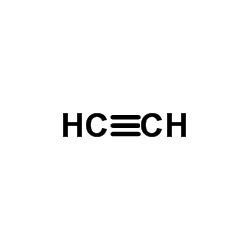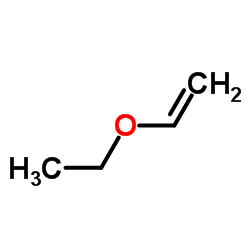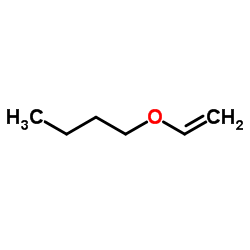1,6-hexanediol divinyl ether

1,6-hexanediol divinyl ether structure
|
Common Name | 1,6-hexanediol divinyl ether | ||
|---|---|---|---|---|
| CAS Number | 19763-13-4 | Molecular Weight | 170.24900 | |
| Density | 0.866g/cm3 | Boiling Point | 233.6ºC at 760mmHg | |
| Molecular Formula | C10H18O2 | Melting Point | N/A | |
| MSDS | N/A | Flash Point | 77.8ºC | |
| Name | 1,6-hexanediol divinyl ether |
|---|---|
| Synonym | More Synonyms |
| Density | 0.866g/cm3 |
|---|---|
| Boiling Point | 233.6ºC at 760mmHg |
| Molecular Formula | C10H18O2 |
| Molecular Weight | 170.24900 |
| Flash Point | 77.8ºC |
| Exact Mass | 170.13100 |
| PSA | 18.46000 |
| LogP | 2.86700 |
| Vapour Pressure | 0.0843mmHg at 25°C |
| Index of Refraction | n20/D 1.446(lit.) |
|
Version 1.2
Regulation (EC) No 1907/2006 1 - Product and Company Information Product Name1,6-HEXANEDIOL DIVINYL ETHER, 97% 2 - Hazards Identification 3 - Composition/Information on Ingredients Product NameCAS #EC noAnnex I Index Number 1,6-HEXANEDIOL DIVINYL ETHER, 97% 19763-13-4 243-277-5 None FormulaC10H18O2 Molecular Weight 170,2500 AMU 4 - First Aid Measures AFTER INHALATION If inhaled, remove to fresh air. If not breathing give artificial respiration. If breathing is difficult, give oxygen. AFTER SKIN CONTACT In case of contact, immediately wash skin with soap and copious amounts of water. AFTER EYE CONTACT In case of contact, immediately flush eyes with copious amounts of water for at least 15 minutes. AFTER INGESTION If swallowed, wash out mouth with water provided person is conscious. Call a physician. 5 - Fire Fighting Measures EXTINGUISHING MEDIA Suitable: For small (incipient) fires, use media such as "alcohol" foam, dry chemical, or carbon dioxide. For large fires, apply water from as far as possible. Use very large ALDRICHwww.molbase.com quantities (flooding) of water applied as a mist or spray; solid streams of water may be ineffective. Cool all affected containers with flooding quantities of water. SPECIAL RISKS Specific Hazard(s): Combustible liquid. Emits toxic fumes under fire conditions. SPECIAL PROTECTIVE EQUIPMENT FOR FIREFIGHTERS Wear self-contained breathing apparatus and protective clothing to prevent contact with skin and eyes. 6 - Accidental Release Measures PROCEDURE(S) OF PERSONAL PRECAUTION(S) Wear respirator, chemical safety goggles, rubber boots, and heavy rubber gloves. METHODS FOR CLEANING UP Absorb on sand or vermiculite and place in closed containers for disposal. Ventilate area and wash spill site after material pickup is complete. 7 - Handling and Storage HANDLING Directions for Safe Handling: Avoid inhalation. Avoid contact with eyes, skin, and clothing. Avoid prolonged or repeated exposure. STORAGE Conditions of Storage: Keep tightly closed. Keep away from heat and open flame. Store in a cool dry place. Store under nitrogen. Incompatible Materials: Avoid contact with acid. 8 - Exposure Controls / Personal Protection ENGINEERING CONTROLS Safety shower and eye bath. Mechanical exhaust required. GENERAL HYGIENE MEASURES Wash thoroughly after handling. Wash contaminated clothing before reuse. PERSONAL PROTECTIVE EQUIPMENT Respiratory Protection: Use respirators and components tested and approved under appropriate government standards such as NIOSH (US) or CEN (EU). Respiratory protection is not required. Where protection is desired, use multi-purpose combination (US) or type ABEK (EN 14387) respirator cartridges. Hand Protection: Compatible chemical-resistant gloves. Eye Protection: Chemical safety goggles. 9 - Physical and Chemical Properties pH N/A BP/BP Range205,000 °C760,000 mmHg MP/MP RangeN/A Flash Point93,000 °CMethod: closed cup FlammabilityN/A ALDRICHwww.molbase.com Autoignition TempN/A Oxidizing Properties N/A Explosive Properties N/A Explosion LimitsN/A Vapor PressureN/A SG/Density0,8870 g/cm3 Partition Coefficient N/A ViscosityN/A Vapor DensityN/A Saturated Vapor Conc. N/A Evaporation RateN/A Bulk DensityN/A Decomposition Temp.N/A Solvent ContentN/A Water ContentN/A Surface TensionN/A ConductivityN/A Miscellaneous DataN/A SolubilityN/A 10 - Stability and Reactivity STABILITY Materials to Avoid: Strong oxidizing agents. HAZARDOUS DECOMPOSITION PRODUCTS Hazardous Decomposition Products: Carbon monoxide, Carbon dioxide. HAZARDOUS POLYMERIZATION Hazardous Polymerization: May occur 11 - Toxicological Information SIGNS AND SYMPTOMS OF EXPOSURE To the best of our knowledge, the chemical, physical, and toxicological properties have not been thoroughly investigated. ROUTE OF EXPOSURE Skin Contact: May cause skin irritation. Eye Contact: May cause eye irritation. Multiple Routes: May be harmful by inhalation, ingestion, or skin absorption. 12 - Ecological Information No data available. 13 - Disposal Considerations SUBSTANCE DISPOSAL This combustible material may be burned in a chemical incinerator equipped with an afterburner and scrubber. Observe all federal, state, and local environmental regulations. 14 - Transport Information RID/ADR Non-hazardous for road transport. IMDG ALDRICHwww.molbase.com Non-hazardous for sea transport. IATA Non-hazardous for air transport. 15 - Regulatory Information COUNTRY SPECIFIC INFORMATION Germany WGK: 3 Self-Classification 16 - Other Information WARRANTY The above information is believed to be correct but does not purport to be all inclusive and shall be used only as a guide. The information in this document is based on the present state of our knowledge and is applicable to the product with regard to appropriate safety precautions. It does not represent any guarantee of the properties of the product. Inc., shall not be held liable for any damage resulting from handling or from contact with the above product. See reverse side of invoice or packing slip for additional terms and conditions of sale. Copyright 2010 Co. License granted to make unlimitedpaper copies for internal use only. DISCLAIMER For R&D use only. Not for drug, household or other uses. ALDRICHwww.molbase.com SECTION 16 - ADDITIONAL INFORMATION N/A |
| HS Code | 2909199090 |
|---|
|
~85% 
1,6-hexanediol ... CAS#:19763-13-4 |
| Literature: Okimoto, Yoshio; Sakaguchi, Satoshi; Ishii, Yasutaka Journal of the American Chemical Society, 2002 , vol. 124, # 8 p. 1590 - 1591 |
|
~85% 
1,6-hexanediol ... CAS#:19763-13-4 |
| Literature: Trofimov, B. A.; Kudyakova, R. N.; Oparina, L. A.; Parshina, L. N.; Vins, V. V. J. Appl. Chem. USSR (Engl. Transl.), 1991 , vol. 64, # 4.2 p. 873 - 877,786 - 790 |
|
~70% 
1,6-hexanediol ... CAS#:19763-13-4 |
| Literature: Nakamura, Aki; Tokunaga, Makoto Tetrahedron Letters, 2008 , vol. 49, # 23 p. 3729 - 3732 |
|
~% 
1,6-hexanediol ... CAS#:19763-13-4 |
| Literature: Ishii, Yasutaka; Nakano, Tatsuya; Inoue, Keizo Patent: US2003/83529 A1, 2003 ; |
|
~96% 
1,6-hexanediol ... CAS#:19763-13-4 |
| Literature: Bosch, Martin; Schlaf, Marcel Journal of Organic Chemistry, 2003 , vol. 68, # 13 p. 5225 - 5227 |
| HS Code | 2909199090 |
|---|---|
| Summary | 2909199090. other acyclic ethers and their halogenated, sulphonated, nitrated or nitrosated derivatives. VAT:17.0%. Tax rebate rate:13.0%. . MFN tariff:5.5%. General tariff:30.0% |
| 3,10-Dioxa-1,11-dodecadiene |
| 1,6-Bisvinyloxyhexan |
| Einecs 243-277-5 |
| Hexanediol 1,6-divinyl ether |
| Hexanediol divinyl ether |
| 1 6-HEXANEDIOL DIVINYL ETHER |





